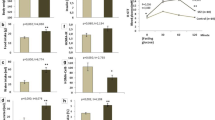Abstract
We examined Se in urine of 170 Saudi Arabian diabetics (19 insulin-dependent [type 1] and 151 insulin-independent [type 2]) and in an equal number of control subjects of the same origin by measuring the ratio of the concentration of this metal (CSe) to that of creatinine in urine (Ccreat) for each subject. The mean (and SEM) of CSe/Ccreat for the control subjects was 56 (2.9) μmol/mol creat, whereas, the value for the diabetics combined or separated into type 1 and type 2 was 56.7 (3.2), 51.5 (6.3), and 57.4 (3.5) μmol/mol creat, respectively. With the exception of type 2 diabetics who were treated with insulin in addition to oral hypoglycemic and diet (35 patients) (mean [SEM]=43 (4.3) μmol/mol creat), there was no significant difference in CSe/Ccreat between the diabetics and control subjects. Also, there was no significant correlation between CSe/Ccreat and age, sex, or weight of diabetics, whereas, the correlation with the degree of diabetic control was significant (p≤0.0136). Of all diabetes-associated disorders (cardiovascular diseases, neuropathy, ophthalmologic diseases, infections, and hepatic disease), only ophthalmologic diseases appears to cause a significant (p≤0.05) reduction in CSe/Ccreat, but only among type 2 diabetics. Inasmuch as Se status is reflected by urinary Se, healthy Saudi Arabians appear to have Se status that is comparable or higher than those reported for other populations.
Similar content being viewed by others
References
X. Chen, G. Yang, J. Chen, Z. Wen, and K. Ge, Studies on the relations of selenium and Keshan disease.Biol. Trace Elem. Res. 2, 91–107 (1980).
Y. Khan, Keshan disease and the selenium research of China,Pedorojisuto 33, 201–212 (1989).
L. C. Clark, The epidemiology of selenium and cancer,Fed. Proc. 44, 2584–2589 (1985).
M. S. Bratakos, T. P. Vouterakos, and V. I. Panayiotis, Selenium status of cancer patients in Greece,Sci. Total Environ. 92, 207–222 (1990).
K. Susuki, K. Suzuki, R. Yanagihara, K. Fujibayashi, H. Okubo, Y. Arakawa et al. The serum selenium concentrations of patients with chronic liver diseases and gastrointestinal cancer,Biomed. Res. Trace Elem. 2, 195, 196 (1991).
A. R. Tanner, I. Bertock, L. Hinks, B. Lloyd, N. R. Turner, and R. Wright, Depressed selenium and vitamin E levels in an alcoholic population. Possible relationship to hepatic injury through increased lipid peroxidation,Dig. Dis. Sci. 31, 1307–1312 (1986).
J. T. Snook, Effect of ethanol use and other lifestyle variables on measures of selenium status,Alcohol 8, 13–16 (1991).
S. G. F. Bukkens, N. de Vos, F. J. Kok, E. G. Schouten, A. M. de Brujin, and A. Hofman, Selenium status and cardiovascular risk factors in healthy Dutch subjects,J. Am. Coll. Nutr. 9, 128–135 (1990).
S. K. Dutta, P. Miller, L. Greenberg, and O. A. Levander, Evidence for selenium depletion in alcoholic subjects admitted for detoxification,Am. J. Clin. Nutr. 35, 845 (1982).
J. L. Schlienger, F. Grunenberger, E. A. Maier, C. Simon, G. Chabrier, and M. J. Leroy, Disorders of plasma trace elements in diabetes. Relation to blood glucose equilibrium,Presse Med. 17, 1076–1079 (1988).
A. Cser, I. Sziklai-Laszlo, H. Menzel, and I. Lombeck, Selenium status and lipoproteins in health and diabetic children,J. Trace Elem. Electrolytes Health Dis 7, 205–210 (1993).
M. Gebre-Medhin, U. Ewald, L. O. Plantin, and T. Tuvemo, Elevated serum selenium in diabetic children,Acta Paediatr. Scand. 73, 109–114 (1984).
E. A. Lebedeva, Relationship between serum selenium level and lipid spectrum in patients with diabetes mellitus type 1,Probl. Endokrinol. (Mosk) 37, 23–25 (1991).
S. Yadav, J. P. Day, V. Mohan, C. Snehalatha, and J. M. Braganza, Selenium and diabetes in the tropics,Pancreas 6, 528–533 (1991).
T. Dohi, K. Kawamura, K. Morita, H. Okamoto, and A. Tsujimimoto, Alterations of the plasma selenium concentrations and the activities of tissue peroxidase enzymes in streptozotocin-induced rats,Horm. Metab. Res. 20, 671–675 (1988).
A. E. Slonim, M. L. Surber, D. L. Page, R. A. Sharp, and I. M. Burr, Modification of chemically induced diabetes in rats by vitamin E. Supplementation minimizes and depletion enhances development of diabetes,J. Clin. Invest. 71, 1282–1128 (1983).
Y. Iizuka, E. Sakurai, and N. Hikichi, Effect of selenium on the serum glucose and insulin levels in diabetic rats,Nippon Yakurigaku Zasshi 100, 151–156 (1992).
T. M. T. Sheehan and M. Gao, Simplified fluorometric assay of total selenium in plasma and urine.Clin. Chem. 36, 2124–2126 (1990).
M. S. Alaejos and C. D. Romero, Urinary selenium concentrations,Clin. Chem. 39, 2040–2052 (1993).
Author information
Authors and Affiliations
Rights and permissions
About this article
Cite this article
El-Yazigi, A., Legayada, E. Urinary selenium in healthy and diabetic Saudi Arabians. Biol Trace Elem Res 52, 55–63 (1996). https://doi.org/10.1007/BF02784089
Received:
Accepted:
Issue Date:
DOI: https://doi.org/10.1007/BF02784089



